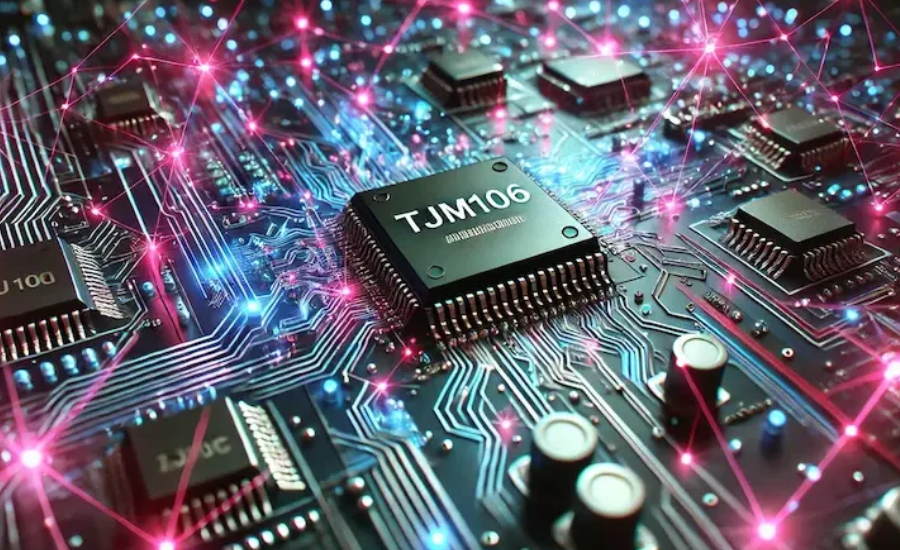The TJMV106 is pivotal in the realms of electronics and industrial technology. Renowned for its versatility and reliability, this semiconductor device is integral to various applications, ranging from everyday consumer electronics to sophisticated industrial systems. This article thoroughly investigates the TJMV106, shedding light on its technical characteristics, multifaceted applications, and its substantial impact on contemporary technology and industry.
Comprehensive Analysis of the TJMV106: Functionality and Development

The TJMV106 is a cutting-edge semiconductor engineered for high-demand applications. Its proven dependability has made it a critical component in advanced electronic systems where consistent operation is essential.
Classification and Role of the TJMV106
- Type: The TJMV106 is categorized as a semiconductor, essential for managing electrical signals across diverse electronic circuits.
- Functionality: Commonly employed for tasks such as switching, amplification, and signal modulation, the TJMV106 demonstrates remarkable adaptability, making it suitable for various circuit designs and application requirements.
Evolution and Progress of the TJMV106
- Origins: The development of the TJMV106 aimed to elevate the performance and reliability of electronic components, particularly in demanding environments. It reflects the latest innovations in semiconductor technology, tailored to the needs of current applications.
- Advancements: Over the years, the TJMV106 has undergone continual refinement, mirroring advancements in semiconductor research and development.
Technical Specifications of the TJMV106: A Detailed Overview
To appreciate the TJMV106’s effectiveness across various applications, it is crucial to explore its technical specifications, which encompass:
Electrical Specifications
- Voltage Rating: The TJMV106 is designed to function within a precise voltage range, guaranteeing dependable performance across diverse conditions, which is vital for compatibility with various electronic circuits.
- Current Management: With its ability to handle substantial current loads, the TJMV106 is exceptionally suited for high-power applications that necessitate efficient current regulation.
- Rapid Switching Capability: The TJMV106 features fast switching capabilities, rendering it highly effective in scenarios requiring quick signal transitions, especially within digital circuits and high-frequency applications.
Physical Attributes
- Packaging Options: The TJMV106 is available in multiple packaging configurations, including surface-mount and through-hole designs, providing flexibility for integration into electronic assemblies.
- Size and Weight: The design of the TJMV106 aligns with standard electronic assembly requirements, optimizing both performance and space efficiency.
Thermal Management Features
- Heat Dissipation: Effective thermal management is vital for the TJMV106’s performance and durability. This component is engineered to dissipate heat generated during operation efficiently.
- Operating Temperature Range: The TJMV106 operates reliably within specified temperature parameters, ensuring consistent performance in a variety of environmental conditions.
Diverse Applications of the TJMV106: From Consumer Electronics to Industrial Machinery
The robust design and technical specifications of the TJMV106 render it ideal for a multitude of applications, including:
Consumer Electronics
- Power Supply Systems: In the consumer electronics domain, the TJMV106 frequently finds application in power supply circuits to stabilize voltage and current, ensuring consistent operation. Its capacity to manage high current loads coupled with rapid switching capabilities makes it a superior choice for efficient power management.
- Audio Equipment: The TJMV106 plays a significant role in audio systems by supporting signal amplification and processing, which enhances both sound quality and overall system performance.
Industrial Applications
- Automation Systems: In the field of industrial automation, the TJMV106 is essential for controlling and switching signals within automated processes. Its reliability and high performance are crucial for maintaining efficiency and precision in these applications.
- Motor Control Systems: The TJMV106 is integral to motor control systems, overseeing the operation of electric motors, including speed and directional adjustments.
Communication Networks
- Signal Processing: The TJMV106 is a vital component in communication systems, facilitating signal processing and modulation. Its rapid switching capabilities are essential for managing high-frequency signals, which is crucial for effective communication.
- Transceiver Applications: The TJMV106 is utilized in transceiver circuits, aiding in the transmission and reception of signals, thereby enhancing the performance and reliability of communication devices.
The TJMV106’s Influence on Modern Technology and Industry

The impact of the TJMV106 on technology and industry is profound, contributing significantly to advancements across multiple dimensions:
Innovations in Semiconductor Technology
- Technological Progress: The TJMV106 embodies the latest advancements in semiconductor technology, integrating features that bolster performance and reliability.
- Efficiency Gains: By optimizing electronic circuit efficiency, the TJMV106 plays a pivotal role in enhancing the overall functionality of modern electronic systems.
Enhancing Electronic System Performance
- Dependability: The robust design of the TJMV106 guarantees consistent performance across various applications, making it indispensable in both consumer and industrial electronics.
- Performance Improvements: With attributes like rapid switching and high current-handling capabilities, the TJMV106 elevates the performance of electronic systems, enabling more efficient and precise operations.
Economic and Industrial Advantages
- Cost Efficiency: By enhancing performance and reliability, the TJMV106 significantly reduces maintenance and repair costs. Its increased efficiency contributes to lower operational expenses for manufacturers and end-users alike.
- Market Influence: The widespread adoption of the TJMV106 in diverse applications highlights its substantial impact on the electronics market. Its prevalent use reflects its essential role in addressing the evolving demands of modern technology.
Real-World Applications: Case Studies Showcasing the Effectiveness of the TJMV106
Analyzing specific case studies illustrates the practical applications and significant influence of the TJMV106:
Case Study 1: Power Supply System Development
- Scenario: A company developing a new power supply system for consumer electronics incorporates the TJMV106 for voltage regulation and current management.
- Outcome: The integration of the TJMV106 results in a power supply system that is markedly more efficient and stable, enhancing the overall performance of electronic devices. This scenario underscores the TJMV106’s effectiveness in optimizing power management.
Case Study 2: Industrial Automation Implementation
- Scenario: In a project focused on industrial automation, the TJMV106 is utilized to regulate signals within an automated assembly line.
- Outcome: The TJMV106’s reliability and rapid switching capabilities improve the efficiency of assembly line operations, ensuring precise control over automated processes. This example demonstrates the TJMV106’s critical value in industrial automation.
Addressing Challenges and Future Directions for the TJMV106
While the TJMV106 offers numerous benefits, it is important to consider certain challenges and potential future developments:
Integration Challenges
- Compatibility Issues: Seamless integration of the TJMV106 with existing electronic systems can pose challenges. It necessitates a comprehensive understanding of the component’s specifications and their alignment with application requirements.
- Design Complexity: Incorporating the TJMV106 into intricate electronic designs may require additional engineering efforts to optimize its performance to meet specific design criteria.
Performance Constraints
- Thermal Management Necessities: Effective thermal management is essential to sustain the TJMV106’s performance and prolong its lifespan. In high-power applications, adequate heat dissipation is vital to prevent overheating and ensure reliable operation.
- Environmental Conditions: Extreme operating conditions, such as high temperatures or frequencies, may influence the TJMV106’s performance. Evaluating its suitability for various application environments is crucial for ensuring optimal functionality.

Future Prospects and Technological Advancements
- Technological Improvements: Upcoming iterations of the TJMV106 may feature enhanced specifications and new capabilities to address current limitations and meet emerging technological needs.
- Integration with New Technologies: The TJMV106 could be adapted to collaborate with cutting-edge technologies, such as advanced communication systems or innovative semiconductor materials, thereby broadening its applications and enhancing performance.
- Expanded Applications: As technology advances, the TJMV106 is poised to find new applications in sectors like renewable energy systems, electric vehicles, and advanced industrial processes. Its versatility and efficacy will drive its increased adoption across various industries.
FAQs about the TJMV106
Q: What is the TJMV106?
A: The TJMV106 is a semiconductor device designed for high-performance applications, characterized by its reliability and versatility. It is commonly used in electronic circuits for tasks such as switching, amplification, and signal modulation.
Q: What are the key technical specifications of the TJMV106?
A: Key specifications include a precise voltage rating for dependable operation, high current management capabilities suitable for demanding applications, rapid switching capabilities for quick signal transitions, and effective thermal management features to dissipate heat efficiently.
Q: In which applications is the TJMV106 commonly used?
A: The TJMV106 is utilized in a variety of applications, including consumer electronics (power supply systems and audio equipment), industrial automation (control systems and motor operations), and communication networks (signal processing and transceivers).
Q: How does the TJMV106 impact modern technology?
A: The TJMV106 significantly influences technological advancements by optimizing electronic circuit efficiency, enhancing the performance of electronic systems, and contributing to cost reductions in manufacturing and operation.
Q: What challenges does the TJMV106 face in its applications?
A: Challenges include potential compatibility issues with existing systems, design complexities for integration into advanced circuits, and the necessity for effective thermal management to prevent overheating.
Q: What does the future hold for the TJMV106?
A: Future advancements may include enhanced specifications, integration with new technologies, and expanded applications in sectors such as renewable energy and electric vehicles, further increasing its relevance in modern industries.
Conclusion
The TJMV106 is a crucial semiconductor component that significantly impacts both consumer electronics and industrial applications due to its impressive technical specifications, such as high current management and rapid switching capabilities, making it suitable for diverse uses, including power supply systems, industrial automation, and communication networks. Evolving alongside advancements in semiconductor technology, the TJMV106 meets the growing demands for efficiency and reliability in modern electronic systems. As technology progresses, it is positioned to adapt and expand its applications in emerging fields like renewable energy and electric vehicles. Overall, the TJMV106’s robust design and proven performance highlight its essential role in advancing modern technology, providing cost-effective solutions and enhancing the efficiency of electronic systems across various industries.
Read Next: myliberla-com-protection-and-community
